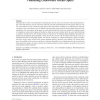Free Online Productivity Tools
i2Speak
i2Symbol
i2OCR
iTex2Img
iWeb2Print
iWeb2Shot
i2Type
iPdf2Split
iPdf2Merge
i2Bopomofo
i2Arabic
i2Style
i2Image
i2PDF
iLatex2Rtf
Sci2ools
CGF
2008
2008
Visualizing Underwater Ocean Optics
Simulating the in-water ocean light field is a daunting task. Ocean waters are one of the richest participating media, where light interacts not only with water molecules, but with suspended particles and organic matter as well. The concentration of each constituent greatly affects these interactions, resulting in very different hues. Inelastic scattering events such as fluorescence or Raman scattering imply energy transfers that are usually neglected in the simulations. Our contributions in this paper are a bio-optical model of ocean waters suitable for computer graphics simulations, along with an improved method to obtain an accurate solution of the in-water light field based on radiative transfer theory. The method provides a link between the inherent optical properties that define the medium and its apparent optical properties, which describe how it looks. The bio-optical model of the ocean uses published data from oceanography studies. For inelastic scattering we compute all freq...
| Added | 09 Dec 2010 |
| Updated | 09 Dec 2010 |
| Type | Journal |
| Year | 2008 |
| Where | CGF |
| Authors | Diego Gutierrez, Francisco J. Serón, Adolfo Muñoz, Oscar Anson |
Comments (0)

